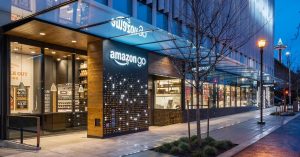By Emily Thompson

It is apparent to me that as a society, we have become much more paranoid about surveillance. Whether it is placing a sticker over your computer camera or clearing the history on your internet browser, we all have moments where we get that eerie sense of being “watched.” The whole idea of constant camera-coverage can seem very dystopian. However, that is the point- we want to believe that this creepy level of surveillance over our daily existence is just that: fiction.
Last week Amazon Go opened in Seattle, Washington. Amazon Go is a grocery/convenience store unlike your average Stop-and-Shop or Fairway, there are no checkouts, a store with no lines. Amazon Go works by having customers download Amazon’s app, create an account and use it to swipe into the store. Once inside, cameras keep track of what you take off of the shelves. Just as you walk out, feeling self conscious and guilty as if you’ve stolen your groceries, Amazon charges your account.
According to New York Times writer Nick Wingfield, “The only sign of the technology that makes this possible floats above the store shelves — arrays of small cameras, hundreds of them throughout the store. Amazon won’t say much about how the system works, other than to say that it involves sophisticated computer vision and machine learning software.” The intricate technology making Amazon Go possible sounds like something out of the next best-selling sci-fi thriller.
Recently in my Texts and Contexts class we have focused on how utopian concepts can become dystopian very quickly – often they are hard to decipher. The idea is that Amazon Go is easier and more convenient for shoppers. It could be the model for the future of shopping. Amazon’s new shopping experience strives for pure utility. But to me it seems that this new environment is slightly creepy. I am not a very suspicious person. I don’t look up conspiracy theories online, nor do I usually care about public surveillance.
But where I struggle to fully accept Amazon Go’s concept is that I don’t think the current system of shopping was flawed enough to deserve this complete overhaul. I can’t see how hundreds of cameras watching whether or not I grab a box of cereal is needed when the current system seems perfectly effective. It also seems like the experience is almost completely void of human interaction. What happened to having a favorite cashier, or getting to know the workers at your local joints?
I do understand the pros of such a system. I believe that Fordham students know very well how one of the key parts of living in a city is constantly waiting in line: to cross the street, to order food, to enter a subway terminal, etc. Having the store in Seattle does cater to the on-the-go lifestyle of the people living there. But also as city dwellers, we can understand that being surrounded by other people all the time can be quite isolating.
Sometimes I feel that the art of being a city-dweller is synonymous with ignoring people, so the concept of Amazon Go is just another way of limiting human interaction within cities. There is that certain homey charm to getting to know the local business owners, or having a bodega to call your own. It makes the process of shopping enjoyable and fulfilling. Computers, no matter how smart, cannot replace people. Utility is only one part of the equation.
This new store is a giant step in the direction of innovation in order to make an often tedious chore more manageable. The fact is that the concept of this new store is so advanced that it will probably find much success just because people want to experience its futuristic qualities for themselves.
At its core, I think Amazon has good intentions with making our shopping experience less of a hassle and more convenient, but the cost of doing so may lead to a future of consumerism that lacks any personal charm. To me, this seems like a drastic step towards a system where people are unable to acknowledge that this level of surveillance (and the willingness to embrace it) might be a step too far.
Emily Thompson, FCRH ’21, is an art history major from Norwalk, Connecticut.




































































































































































































